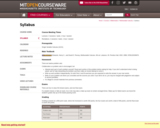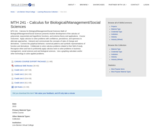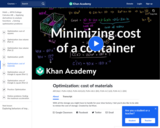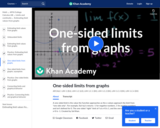
This video is from the Khan Academy subject of Math on the topic of Calculus and it covers Limits to define continuity.
- Subject:
- Calculus
- Mathematics
- Material Type:
- Lesson
- Provider:
- Khan Academy
- Author:
- Sal Khan
- Date Added:
- 09/22/2013

This video is from the Khan Academy subject of Math on the topic of Calculus and it covers Limits to define continuity.

This video is from the Khan Academy subject of Math on the topic of Calculus and it covers Limits with two horizontal asymptotes.

Concrete example using a line integral

Using line integrals to find the work done on a particle moving through a vector field

This course covers vector and multi-variable calculus. It is the second semester in the freshman calculus sequence. Topics include vectors and matrices, partial derivatives, double and triple integrals, and vector calculus in 2 and 3-space.
MIT OpenCourseWare offers another version of 18.02, from the Spring 2006 term. Both versions cover the same material, although they are taught by different faculty and rely on different textbooks. Multivariable Calculus (18.02) is taught during the Fall and Spring terms at MIT, and is a required subject for all MIT undergraduates.

Math of Biological/Management/Social Sciences presents intuitive development of the calculus of polynomial, exponential and logarithmic functions, and extrema theory and applications.
Course Outcomes:
1. Apply calculus to solve problems with confidence, persistence, and openness to alternate approaches.
2. Interpret and communicate the concepts of rates of change and derivatives.
3. Connect the graphical behavior, numerical patterns and symbolic representations of function and derivatives.
4. Collaborate to solve calculus problems related to their field of study.
5. Recognize when and how to proficiently apply calculus tools to solve problems in business management, social sciences and and biological sciences.
6. Use a graphing calculator and/or other technology to solve applied problems.

Intuition behind the Mean Value Theorem

This video is from the Khan Academy subject of Math on the topic of Calculus and it covers Minimizing combined area.

This video is from the Khan Academy subject of Math on the topic of Calculus and it covers Minimizing sum of squares.

This video is from the Khan Academy subject of Math on the topic of Calculus and it covers Minimizing the cost of a storage container.

This video is from the Khan Academy subject of Math on the topic of Calculus and it covers More limits at infinity.

Why we study differential calculus

This video is from the Khan Academy subject of Math on the topic of Calculus and it covers One-sided limits from graphs.

Differential and Integral Calculus of elementary functions with an emphasis on business and social science applications. Designed for students who want a brief course in Calculus. MATH 148 is a calculus course for business students. It is designed for students who want a brief course in calculus. Topics include differential and integral calculus of elementary functions. Problems emphasize business and social science applications. Translating words into mathematics and solving word problems are emphasized over algebra. Applications are mainly business oriented (e.g. cost, revenue, and profit). Mathematical theory and complex algebraic manipulations are not mainstays of this course, which is designed to be less rigorous than the calculus sequence for scientists and engineers. Topics are presented according to the rule of four: geometrically, numerically, analytically, and verbally. That is, symbolic manipulation must be balanced with graphical interpretation, numerical examples, and writing. Trigonometry is not part of the course.

Upon successful completion of Math 151, the student should be able to: 1) Calculate or estimate limits of functions given by formulas, graphs, or tables; also using properties of limits and L'hopital's Rule. 2) State whether a function given by a graph or formula is continuous or differentiable at a given point or on a given interval and justify your answer. 3) Calculate average and instantaneous rates of change in context, and state the meaning and units of the derivative for functions given graphically. 4) Calculate derivatives of polynomial, rational, common transcendental functions, combinations of these functions, and implicitly defined functions. 5) Apply the ideas and techniques of derivatives to solve maximum and minimum problems, solve related rate problems, and calculate slopes and rates for function given as parametric equations (optional).6) Find extreme values of modeling functions given by formulas or graphs: predict, construct and interpret the shapes of graphs, solve equations (i.e. Newton's Method), and find linear approximations of functions (differentials). 7) Estimate a slope, a rate of change and the reasonableness of a result. 8) Restate in words the meanings of the solutions to applied problems, attaching the appropriate units to an answer.9) State which parts of a mathematical statement are assumptions (hypotheses) and which parts are conclusions.

Continues the study of integration, emphasizing applications and special techniques. Students work with algebraic and transcendental functions.

Continues the study of integration, emphasizing applications and special techniques. Students work with algebraic and transcendental functions.

Emphasizes the study of infinite sequences and series including power series. Topics include plane analytic geometry, graphing in polar coordinates, and an introduction to vectors.

Emphasizes the study of infinite sequences and series including power series. Topics include plane analytic geometry, graphing in polar coordinates, and an introduction to vectors.

This course will cover families of trigonometric functions, their inverses, properties, graphs, and applications. Additionally we will study trigonometric equations and identities, the laws of sines and cosines, polar coordinates and graphs, parametric equations and elementary vector operations.